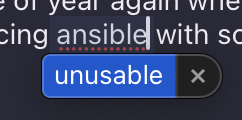A small group of us are working on community level hosting of 'self-hosted' FOSS tools (think #NextCloud and more) setup as a local service offering for local grassroots organisations. We're seeking advice/tips/guidance.
We're keen to do some orchastration but want to avoid the complexity of say Kubernetes.
As a start we were looking at Ansible with Docker Swarm but we're now exploring other alternatives.
Anyone have experience at this sort of hobbist just a bit bigger than #HomeLab Ops scale?
#Pyinfra is being considered as an Ansible, in the projects words "Think ansible but Python instead of YAML, and a lot faster." (https://pyinfra.com)
Anyone have experience at this homelab/small hosting level? Would love any tips/suggestions for tools/approaches.
One source of inspiration is the 12Factor app methodology: https://12factor.net
Personally, as a rubyist I'm always keen to know what the ruby community is doing in this space also.
Haven't seen many others doing work at this scale, lets use the tag #CommunityHosting to keep connected :)
cc: @jadehopepunk @ryan @gilbert @bounding_star @steph @moxvallix @organvoid @teq
#CommunityHosting #Python #DevOps #ruby #RubyOnRails #SelfHosting #Orchastration #FOSS #OpenTofu #SelfHosting #SelfHosted
![Screenshot of the following Python code:
from hcloud.firewalls import (
FirewallResource,
FirewallResourceLabelSelector,
FirewallRule,
)
from pyinfra import host
from pyinfra_hcloud import operations as hco
WHOLE_INTERNET = ["0.0.0.0/0", "::/0"]
hco.firewall(
name="default firewall",
handle="default",
rules=[
FirewallRule(
description="allow all ICMP",
direction="in",
protocol="icmp",
source_ips=WHOLE_INTERNET,
),
FirewallRule(
description="allow SSH from anywhere",
direction="in",
protocol="tcp",
port="22",
source_ips=WHOLE_INTERNET,
),
],](https://files.mastodon.social/cache/media_attachments/files/114/432/846/696/347/431/small/6fcee40d1715ae76.png)
![Screenshot of the following Python code:
for handle, pubkey in host.data.get("ssh_keys", {}).items():
hco.ssh_key(
name=f"SSH key: {handle}",
handle=handle,
public_key=pubkey,
)
for i in range(1, host.data.map_servers + 1):
inum = f"{i:02}"
hco.volume(
name=f"volume: mapdata{inum}",
handle=f"mapdata{inum}",
location=host.data.location,
size=host.data.mapdata_volume_size_gb,
format="ext4",
labels={"contents": "mapdata", "filesystem": "ext4"},
)
for ipv in ["v4", "v6"]:
hco.primary_ip(
name=f"primary IP{ipv}: map{inum}",
handle=f"map{inum}_{ipv}",
type=f"ip{ipv}",
datacenter=host.data.datacenter,
dns_ptr=f"map{inum}.{host.data.domain}",
)
hco.server(
name=f"server: map{inum}",
handle=f"map{inum}.{host.data.domain}",
server_type=host.data.map_server_type,
image=host.data.map_server_image,
datacenter=host.data.datacenter,
ipv4=f"map{inum}_v4",
ipv6=f"map{inum}_v6",
ssh_keys=host.data.ssh_keys,
volumes=[f"mapdata{inum}"],
labels={"application": "map"},
)](https://files.mastodon.social/cache/media_attachments/files/114/432/846/730/008/564/small/2a93abd1b0209337.png)
